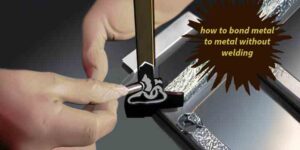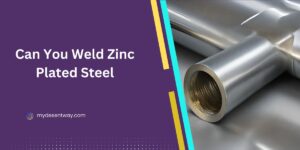Table of Contents
- How do you connect metal to metal without welding?
- 2. Mechanical Fastening
- Identifying the Best Adhesive for Metal to metal-to-metal bonding
- 3. Brazing
- 4. Soldering
- 5. Riveting
- 6. Epoxy Resin
- 7. Mechanical Interlocking
- 8. Mechanical Clinching
- 9. Magnetic Bonding
- 10. Expansion Fitting
- Will Gorilla Glue Work on Metal to Metal?
- Does Heavy-Duty Liquid Nails Bond to Metal?
- How to Bond Metal Brackets to a Metal Tank Without Welding
- Conclusion
- FAQs about How to Bond Metal to Metal Without Welding
If you are working on a project that involves metal, you might be wondering how to bond metal to metal without welding. While welding is a common method, it requires specialized equipment and can be complex for those without welding experience.
Fortunately, there are alternative techniques that allow you to bond metal without the need for welding. In this guide, we will explore several effective methods to achieve a solid and durable bond between metal surfaces.
How do you connect metal to metal without welding?
Welding has long been a traditional method for joining metals, but it may not always be feasible or practical for specific projects. Fortunately, there are alternative approaches to achieving a secure bond between metal surfaces without using heat and welding equipment.
1. Adhesive Bonding
One of the most popular and versatile methods for connecting metal to metal is adhesive bonding. Adhesives offer several advantages, such as easy application, a wide range of bonding capabilities, and the ability to join dissimilar metals. Here’s a step-by-step guide to using adhesive for metal bonding:
- Surface Preparation: Ensure that the metal surfaces are clean, dry, and free from any contaminants like oil, grease, or rust. Roughening the surface slightly can enhance the adhesive’s grip.
- Choosing the Right Adhesive: Select an adhesive designed explicitly for metal-to-metal bonding. Epoxy adhesives, polyurethane adhesives, and cyanoacrylate (super glue) adhesives are commonly used for this purpose.
- Application: Apply the adhesive evenly on both metal surfaces. Follow the manufacturer’s instructions for the appropriate amount of adhesive to use.
- Joining the Metals: Press the metal parts together firmly and hold them in place for the curing time specified by the adhesive manufacturer. Clamps or other holding mechanisms can be used to keep the parts in position during curing.
- Curing Time: Allow sufficient time for the adhesive to cure completely. This may vary depending on the type of adhesive used and environmental conditions.
2. Mechanical Fastening
Mechanical fastening is another reliable technique for bonding metal to metal. This method involves using screws, bolts, nuts, or rivets to secure the metal parts together. Mechanical fasteners provide a sturdy connection and can be used in various applications, from light-duty to heavy-duty projects.
Identifying the Best Adhesive for Metal to metal-to-metal bonding
Selecting the appropriate adhesive is crucial for achieving a solid and durable metal-to-metal bond. Several factors should be considered when choosing the best adhesive for your specific project:
- Materials: Identify the types of metals you want to bond, as different adhesives work better with certain metals.
- Strength Requirements: Assess the load-bearing requirements of the joint to determine the adhesive’s strength needed.
- Environmental Conditions: Consider the environmental factors the adhesive will be exposed to, such as temperature, moisture, and chemical exposure.
- Curing Time: Evaluate the available time for the adhesive to cure and achieve full strength.
Based on these considerations, epoxy adhesives are generally regarded as one of the best choices for metal-to-metal bonding. They offer high strength, excellent resistance to environmental factors, and work well with various metals.
3. Brazing
Brazing is a metal bonding process that involves using a filler material with a lower melting point than the base metals. The filler material is heated until it melts and then flows between the metal joints, creating a strong bond upon solidification. Brazing requires a torch or a furnace to reach the appropriate temperature for the filler material to melt.
4. Soldering
Soldering is similar to brazing, but it uses a filler material with an even lower melting point, typically a solder alloy. Soldering is well-suited for joining smaller metal components and delicate electronic parts. It requires a soldering iron to heat the filler material and achieve a secure bond between the metal surfaces.
5. Riveting
Riveting involves using metal rivets to connect two metal pieces. The process requires drilling holes through the metal parts and then inserting the rivets, which are then secured by flattening or deforming the exposed end. Riveting is a sturdy and permanent method suitable for various applications.
6. Epoxy Resin
Epoxy resin is a versatile adhesive commonly used in various bonding applications. It works exceptionally well for metal-to-metal bonding, providing a durable and reliable connection. Epoxy resin is available in various formulations, and some are specifically designed for heavy-duty industrial applications.
7. Mechanical Interlocking
Mechanical interlocking is a technique where the metal pieces are designed with specific shapes that fit together like puzzle pieces. When assembled, the interlocking shapes create a strong bond, effectively joining the metal parts without the need for additional adhesives or fasteners.
8. Mechanical Clinching
Mechanical clinching is a cold-forming process that joins metal sheets without heat or additional materials. It involves deforming the metal layers to create a secure connection. This method is commonly used in the automotive and sheet metal fabrication industries.
9. Magnetic Bonding
In some cases, magnetic bonding can be used to join metal parts. This method relies on powerful magnets to hold the metal pieces together. While not suitable for heavy loads or critical applications, magnetic bonding can be adequate for specific scenarios.
10. Expansion Fitting
Expansion fitting, also known as interference fitting, involves inserting one metal part into another with a tight fit. As the inserted part expands, it creates pressure against the surrounding metal, forming a secure bond. This method is often used in plumbing and assembly applications.
Will Gorilla Glue Work on Metal to Metal?
Yes, Gorilla Glue is known to work on metal-to-metal bonding. Gorilla Glue is a polyurethane adhesive that offers strong adhesion to various materials, including metals. When using Gorilla Glue for metal bonding, it is essential to prepare the surfaces properly and apply the adhesive as per the manufacturer’s instructions. Once cured, Gorilla Glue forms a durable and reliable bond between metal surfaces.
Does Heavy-Duty Liquid Nails Bond to Metal?
Yes, heavy-duty liquid nails are designed to bond to various materials, including metals. As a construction adhesive, Heavy Duty Liquid Nails offers exceptional strength and is suitable for heavy-duty applications.
When using Heavy Duty Liquid Nails for metal-to-metal bonding, it is crucial to clean and prepare the metal surfaces adequately before applying the adhesive. Following the manufacturer’s instructions for application and curing will ensure a reliable bond.
How to Bond Metal Brackets to a Metal Tank Without Welding
Conclusion
There are numerous effective alternatives to welding when it comes to bonding metal to metal. Whether you choose adhesive bonding, mechanical fastening, brazing, soldering, riveting, or other methods, each has its unique advantages and is suitable for specific applications.
Consider the requirements of your project, the load-bearing capacity needed, and the environmental conditions to select the most appropriate bonding technique. By following proper preparation and execution, you can achieve a solid and durable bond between metal surfaces without the need for welding, opening up possibilities for a wide range of projects and applications.
FAQs about How to Bond Metal to Metal Without Welding
How can I bond metal to metal without welding?
There are several methods to bond metal to metal without welding, including adhesive bonding, mechanical fastening, brazing, soldering, and using bonding agents like epoxy or polyurethane adhesives.
What are some alternatives to welding for metal bonding?
Alternatives to welding for metal bonding include adhesive bonding, mechanical fastening (such as bolts, screws, or rivets), brazing, soldering, and using bonding agents like epoxy or polyurethane adhesives.
Is it possible to achieve strong bonds without welding metals?
Yes, it is possible to achieve strong bonds without welding metals. Adhesive bonding, mechanical fastening, brazing, soldering, and using bonding agents like epoxy or polyurethane adhesives can all create robust connections between metal surfaces.
What techniques can be used to join metal surfaces without welding?
Techniques for joining metal surfaces without welding include adhesive bonding, where a strong adhesive is applied between the surfaces and allowed to cure, and mechanical fastening, where fasteners like bolts, screws, or rivets are used to secure the metals together.
Brazing and soldering involve melting a filler material to bond the metals while using bonding agents like epoxy or polyurethane adhesives, which can also effectively join metal surfaces.
Are there any adhesive solutions for bonding metal without welding?
Yes, there are adhesive solutions specifically designed for bonding metal without welding. Epoxy adhesives, polyurethane adhesives, and other specialized bonding agents are available for creating solid and durable bonds between metal surfaces without the need for welding.










3 thoughts on “How to Bond Metal to Metal without Welding?”